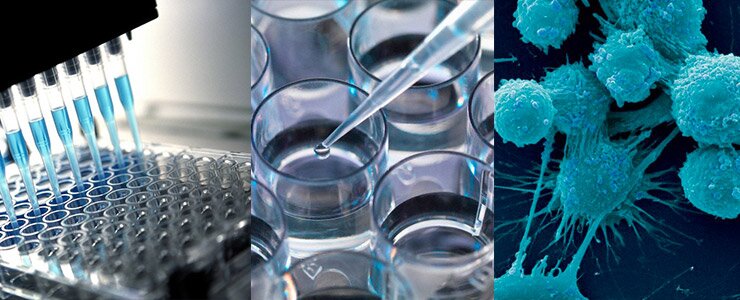Cell-based Services
An Overview of Drug Testing and Toxicology Studies

Stem Cells in Predictive Toxicology
There is a broad consensus in the biopharmaceutical industry and within the regulatory authorities, that a significant improvement of the current in vitro test methodologies for accurate assessment and prediction of drug effects is required. The need for an improved and uniform physiological response, normal genotype and growth pattern has redirected drug discovery efforts towards stem cells, which are cost effective and provide reproducible results. Also, the role of stem cells in many chronic diseases such as cancer, birth defects and other developmental disorders demands for stem cell based toxicity studies.
Cancer Stem Cell Based Cytotoxicity Studies
Cancer is so prevalent that it hasn’t failed to garner worldwide attention and there are many questions swirling around its biology, origin, prognosis, diagnosis, progression etc. Therefore, it is imperative to design cell culture systems that aid the understanding of complexity involved in cancer cell biology.
The Cancer Stem Cell (CSC) theory has drawn much attention in the scientific fraternity that elucidates not only the issue of tumour initiation and development and tumour’s ability to metastasize and reoccur, but also, the ineffectiveness of conventional cancer therapy. Therefore, it is crucial to study the effect of drugs specifically targeting CSCs that could eliminate cancer, and to prevent the undesired effects on healthy cells. Alongside, we intend to use cancer cell lines to conduct toxicity studies.
Cardiovascular Diseases and Diabetes Related Models
Cardiovascular diseases (CVDs) are one of the leading causes of mortality worldwide. According to the World Health Organization (WHO), 80% of deaths occur in the low and middle income countries. In India, morbidity due to CVDs is majorly attributed to dietary factors, diabetes and high blood glucose levels. For this reason, we implement several cardiovascular mimicking models, such as endothelial dysfunction, in vitro diabetic models with high glucose, foam cell formation, migration and wound healing assays, reverse cholesterol transport in vitro assays and ex vivo angiogenesis model (e.g., carotid artery). These are established as preliminary steps for potent drug discovery and screening related to diabetes and cardiovascular diseases.
Primary Cell Based Toxicity Studies
Freshly harvested and expanded primary cells from tumours and/or from other biological material, with good in vitro/in vivo correlation can be used as an alternative to the established cell lines and we look forward to develop such primary cell based testing platforms to be used in the fields of both cancer and cardiovascular biology.
Coagulation Factor Studies
In addition to cardiovascular models, we perform blood clotting and platelet aggregation related assays to understand haemostatic functions in cardiovascular and coagulation disorders. Our in-house assays and experimental set-up aid us in finding potential cardiovascular targets for in vitro preclinical testing and discovery.
3D In Vitro Anticancer Drug Screening Models
Reconstitution of the in vivo micro environment is one of the bottlenecks to be overcome in the in vitro anticancer drug studies, which has been long constrained by conventional 2D cell culture systems that may not accurately mimic the 3D environment in which cancer cells reside in vivo. The dynamics of 2D models differ from 3D models at multiple levels, starting from nutrient and gaseous state in the medium to the growth conditions, micro environment and secretion of paracrine and autocrine factors. As a result, 2D environment may provide limited data regarding the predicted response of cancer cells to chemotherapeutics which may not be satisfactory.
To address these short comings of the 2D systems, we propose applying 3D culture technique for screening anticancer drugs. Tumour spheroids derived from CSCs naturally mimic tumours with inherent metabolic (oxygen, carbon-di-oxide, nutrients and wastes), proliferative gradients, and establish physiological cell-cell and cell-substrate interactions that regulate proliferation and differentiation. Thus, they serve as excellent tumour models which are much closer to the human physiological conditions and possibly yielding more reliable and meaningful therapeutic results compared to 2D models.


